
Parallax and Textured Website Design
Parallax and textured website design: It’s more than just a pretty picture; it’s about crafting an immersive online experience. Think layers subtly shifting as you scroll, textures adding depth and personality – it’s a powerful combination that can elevate a website from ordinary to unforgettable. We’ll dive into the how and why, exploring the technical aspects alongside the creative possibilities.
This post explores the fascinating world of parallax scrolling and textured website design. We’ll unpack the core principles, delve into practical implementation using CSS and JavaScript, and examine the impact on user experience and engagement. From choosing the right textures to optimizing for different screen sizes, we’ll cover everything you need to know to create stunning and user-friendly websites.
Defining Parallax and Textured Website Design

Source: pinimg.com
Parallax scrolling and textured website design are two distinct yet often complementary techniques used to enhance the visual appeal and user experience of websites. They move beyond the limitations of static web pages, creating more engaging and immersive online experiences. This post will delve into the core principles of each, exploring their implementation and impact.Parallax scrolling creates a 3D-like effect by moving background elements at a slower speed than foreground elements as the user scrolls.
This simulates depth and perspective, giving the illusion of layers moving past each other. The result is a visually dynamic and engaging experience that can significantly enhance the overall user journey.
Parallax Scrolling Principles
Parallax scrolling relies on the manipulation of the relative speeds of different layers within a website’s design. The background layer often moves slower than the foreground, creating the illusion of depth. This effect is achieved through CSS or JavaScript, allowing developers to precisely control the speed and movement of each layer. Successful parallax scrolling requires careful consideration of element placement and timing to avoid jarring or disorienting effects.
It’s crucial to maintain a balance between visual interest and usability, ensuring that the parallax effect doesn’t hinder navigation or readability.
Texture in Website Design
Texture plays a vital role in enhancing the aesthetic appeal and usability of a website. It adds depth and visual interest, making the design more engaging and memorable. Textures can evoke emotions and create a specific mood or atmosphere, contributing significantly to the overall brand identity and user experience. A website with well-integrated textures feels more tactile and less flat, increasing user engagement and creating a more immersive experience.
The choice of texture should always align with the overall design and branding of the website.
Types of Website Textures
There’s a wide variety of textures that can be used in website design. Each type offers unique visual characteristics and can contribute to different design aesthetics.
- Photographic Textures: These textures use actual photographs of materials like wood, fabric, or stone. They provide a realistic and often organic feel, lending authenticity to the design. For example, a high-resolution image of distressed wood could be used as a background for a rustic-themed website.
- Illustrated Textures: These textures are created using illustrations or vector graphics. They can be highly stylized and offer more design control than photographic textures. An example would be a repeating pattern of hand-drawn flowers used as a subtle background element.
- Geometric Textures: These textures are based on geometric shapes and patterns. They can range from simple repeating patterns to complex, intricate designs. A website featuring a subtly textured background of overlapping hexagons would be an example of this type of texture.
Technical Implementation of Parallax Effects
Parallax effects can be implemented using both CSS and JavaScript. CSS-based parallax is simpler for less complex effects, often utilizing the `background-attachment: fixed;` property to create a fixed background that moves slower than the foreground content as the user scrolls. This approach is generally less resource-intensive.For more complex and dynamic parallax effects, JavaScript libraries and frameworks like ScrollMagic or similar solutions provide more control and flexibility.
These allow for intricate animations and interactions, making it possible to create truly stunning visual experiences. JavaScript offers the power to handle multiple layers with precise speed and timing control, enabling more sophisticated and visually impressive parallax scrolling effects. However, it’s important to balance visual complexity with website performance, ensuring the parallax effect doesn’t negatively impact loading times or overall usability.
Visual Impact and User Experience
Parallax scrolling and textured website design significantly impact a website’s visual appeal and user experience. These techniques, when used effectively, can create a more engaging and memorable online experience, but poorly implemented, they can lead to frustration and a negative perception. Understanding the interplay between visual impact, user experience, and technical considerations is crucial for successful web design.
The combination of parallax and texture offers a powerful toolset for designers. Parallax, with its layered scrolling effect, adds depth and visual interest, drawing the user deeper into the website’s content. Textures, on the other hand, contribute to the overall feel and professionalism of the site, enhancing its tactile and emotional appeal. However, this potent combination needs careful handling to avoid compromising performance or usability.
Parallax Scrolling’s Influence on User Engagement and Navigation
Parallax scrolling enhances user engagement by creating a more dynamic and interactive experience than traditional scrolling. The subtle movement of background elements as the user scrolls adds a sense of depth and realism, making the content feel more alive. This can lead to increased time spent on the site and improved content absorption. However, excessive or poorly implemented parallax can be disorienting and hinder navigation.
Effective use requires a balance between visual interest and ease of use; clear calls to action and intuitive navigation remain paramount. For example, a website showcasing travel destinations might use parallax to smoothly transition between images of different locations, creating a sense of journey and exploration.
Texture’s Impact on Perceived Website Quality and Professionalism, Parallax and textured website design
The use of texture significantly influences the perceived quality and professionalism of a website. Well-chosen textures can create a sophisticated and polished look, adding a layer of visual richness that goes beyond simple images and text. Textures can evoke specific emotions and brand identities; for example, a rough, textured background might suit a rustic, handcrafted brand, while a smooth, sleek texture might be more appropriate for a modern, tech-focused company.
Conversely, poorly chosen or overly used textures can make a website appear cluttered or unprofessional. The key is to use texture subtly and strategically, complementing the overall design rather than overpowering it.
The Relationship Between Parallax Effects and Website Loading Speed
Parallax effects, particularly those involving high-resolution images or videos, can significantly impact website loading speed. Larger files take longer to download, leading to a slower user experience. Optimizing images, using efficient coding practices, and employing lazy loading techniques are crucial for mitigating this issue. A poorly optimized parallax website can result in high bounce rates and negative user reviews.
Striking a balance between visual impact and performance is essential. Techniques such as using compressed images and strategically placing parallax elements can help minimize the impact on loading times.
Examples of Effective Parallax and Texture Website Design
The effective use of parallax and texture is demonstrated by many successful websites. Below is a table showcasing some examples:
| Website URL | Description of Parallax Use | Description of Texture Use | Overall User Experience Assessment |
|---|---|---|---|
| (Example URL 1 – Replace with a real example) | Subtle parallax scrolling used to reveal additional content sections as the user scrolls down the page, creating a smooth transition between sections. | A subtle linen texture is used as a background, giving a feeling of warmth and sophistication. | Positive – Engaging and visually appealing without sacrificing usability. |
| (Example URL 2 – Replace with a real example) | Dramatic parallax effects used to create a sense of depth and immersion, with background elements moving at different speeds. | A combination of textures is used, with a rough, stone-like texture for the header and a smoother, metallic texture for the navigation bar. | Positive – Visually stunning, but could be improved by optimizing loading speed. |
| (Example URL 3 – Replace with a real example) | Minimal parallax scrolling used to subtly highlight key elements on the page, enhancing visual hierarchy. | A simple, clean texture is used as a subtle background element, creating a professional and modern feel. | Positive – Effective and visually appealing without being overwhelming. |
| (Example URL 4 – Replace with a real example) | No parallax used, focusing instead on a strong visual hierarchy and clear navigation. | A textured background image is used to create visual interest and enhance branding. | Positive – Clean, simple, and effective. Demonstrates that parallax isn’t always necessary. |
Design Considerations and Best Practices
Parallax scrolling and textured backgrounds can dramatically enhance a website’s visual appeal, but their successful implementation hinges on careful consideration of usability and technical limitations. Overusing these elements can lead to a frustrating user experience, so a balanced approach is crucial. This section delves into best practices to ensure your website is both beautiful and functional.
Best Practices for Integrating Parallax and Texture
Effective integration of parallax and texture requires a delicate balance. Prioritize readability and accessibility. Ensure text and interactive elements remain easily visible and accessible, even against busy textured backgrounds. Use high-resolution textures to avoid pixelation on high-resolution screens. Keep parallax effects subtle and avoid overly fast or jarring movements.
Test thoroughly across different browsers and devices to ensure consistent performance. Consider using a parallax library or plugin to simplify implementation and ensure smooth scrolling. Finally, remember that less is often more. Overuse of parallax can lead to a disorienting and nauseating user experience.
Potential Challenges and Limitations of Parallax Scrolling and Textured Backgrounds
While visually stunning, parallax scrolling and textured backgrounds present certain challenges. Parallax effects can be resource-intensive, potentially slowing down page load times, especially on mobile devices. Complex parallax animations can negatively impact by hindering crawlers from properly indexing the content. Textured backgrounds, if not carefully chosen, can reduce readability and contrast, making the website inaccessible to users with visual impairments.
Furthermore, poorly implemented parallax can cause motion sickness in some users. Careful planning and optimization are crucial to mitigate these limitations.
Optimizing Parallax Effects for Different Screen Sizes and Devices
Responsive design is paramount when incorporating parallax. The effect should adapt seamlessly to various screen sizes and devices, from desktops to smartphones and tablets. Avoid fixed-pixel values and instead use percentage-based or fluid layouts. Consider using different parallax speeds and intensities for different screen sizes to maintain visual harmony. Thorough testing across multiple devices is essential to identify and address any responsiveness issues.
Lazy loading techniques can improve performance on mobile devices by delaying the loading of background images until they are visible in the viewport.
Mock-up of a Website Incorporating Parallax and Texture
Imagine a website for a fictional artisanal coffee roaster called “Bean There, Brewed That.” The target audience is coffee aficionados and individuals seeking a premium coffee experience. The website’s purpose is to showcase the company’s story, coffee varieties, and online store.The homepage features a subtle parallax effect. As the user scrolls down, a high-resolution image of coffee beans subtly moves at a slower speed than the background, creating a sense of depth.
The background texture is a subtle, slightly desaturated image of burlap, providing a rustic feel without overpowering the content. The main text and call-to-action buttons are prominently displayed against this background, ensuring high readability and contrast.The “About Us” section utilizes a more pronounced parallax effect. As the user scrolls, images of the coffee roastery and the team appear to move past the background, revealing more of the story behind the company.
This section uses a slightly darker burlap texture to create a more intimate and inviting atmosphere.The “Our Coffee” section showcases different coffee varieties with individual parallax effects. Each variety’s image moves slightly as the user scrolls, drawing attention to the specific bean and its description. The background texture here is a subtle, repeating pattern of coffee bean silhouettes, adding visual interest without distracting from the product information.Throughout the website, a consistent color palette of warm browns, creams, and deep reds is used to create a cohesive and inviting brand experience.
The font choices are clean and legible, ensuring easy readability against the textured backgrounds. The parallax effects are subtle and well-integrated, enhancing the user experience without causing distraction or discomfort.
Accessibility and Inclusivity
Parallax scrolling and textured backgrounds, while visually stunning, can present significant accessibility challenges if not carefully considered. These design elements, if implemented without proper attention to inclusivity, can create barriers for users with disabilities, hindering their ability to navigate and understand the website’s content. This section explores the key accessibility implications and Artikels strategies for creating inclusive and accessible websites that leverage these design techniques responsibly.
The inherent dynamism of parallax scrolling, with its layered elements moving at different speeds, can be disorienting for users with motion sensitivity, cognitive impairments, or neurological conditions such as epilepsy. Similarly, heavily textured backgrounds, while aesthetically pleasing, can reduce the contrast between foreground text and background imagery, making it difficult for users with low vision or visual impairments to read the content.
Furthermore, the use of complex animations and transitions, often associated with these design styles, might not be compatible with assistive technologies such as screen readers.
Techniques for Ensuring Website Accessibility
Creating an accessible website requires proactive measures to address the potential challenges posed by parallax and textured designs. This involves careful consideration of color contrast, clear visual hierarchy, keyboard navigation, and compatibility with assistive technologies. For example, providing alternative text descriptions for all images and ensuring sufficient color contrast between text and background are crucial steps. Implementing keyboard navigation allows users who cannot use a mouse to navigate the site effectively.
Thorough testing with assistive technologies like screen readers ensures the site functions correctly for users relying on them.
Examples of Inclusive Design Practices
Consider a website showcasing a product using parallax scrolling. Instead of relying solely on the visual animation to convey information, provide clear, concise text descriptions alongside the visuals. This approach ensures that users with disabilities can still understand the product details even if they cannot fully experience the parallax effect. Similarly, when using textured backgrounds, ensure the textures are subtle and don’t interfere with the readability of text.
Using a less obtrusive texture or reducing its opacity can significantly improve accessibility without sacrificing visual appeal. Providing users with the option to disable or reduce the intensity of parallax effects, perhaps through a settings menu, allows for personalized accessibility.
Guidelines for Designing Accessible Websites with Parallax and Texture
Designing accessible websites that incorporate parallax and textured backgrounds requires a mindful approach. The following guidelines help ensure your website is inclusive and usable for all:
- Maintain sufficient color contrast: Ensure a significant contrast ratio between text and background colors, adhering to WCAG guidelines (e.g., at least 4.5:1 for normal text).
- Provide alternative text for all images: Include descriptive alt text for all images, especially those conveying information crucial to understanding the content.
- Ensure keyboard accessibility: Make sure all interactive elements are navigable using only a keyboard.
- Test with assistive technologies: Thoroughly test the website with screen readers and other assistive technologies to identify and address any accessibility issues.
- Minimize motion and animation: Reduce or eliminate potentially disorienting motion effects. Offer users the option to disable or adjust animations.
- Use clear visual hierarchy: Organize content logically and use visual cues like headings and spacing to improve readability.
- Provide clear and concise text: Avoid overly complex language and ensure the content is easy to understand.
- Consider providing a non-parallax version: For users who find parallax scrolling problematic, consider offering a simplified, non-parallax version of the website.
Creative Applications and Future Trends: Parallax And Textured Website Design
Parallax scrolling and textured designs, while seemingly simple techniques, offer a surprisingly vast canvas for creative expression. Their ability to blend aesthetics with interactivity opens doors to innovative website experiences that go beyond the static. Let’s explore how these design elements are being used, and where they might be headed.Parallax and texture aren’t just visual embellishments; they’re powerful tools for shaping user experience and enhancing storytelling.
By layering visuals and creating subtle movement, designers can guide the user’s eye, build anticipation, and control the narrative flow. The careful application of texture can evoke emotion, create a sense of depth, and reinforce a website’s overall brand identity.
Innovative Uses of Parallax and Texture
Parallax scrolling is being increasingly used to create immersive experiences, particularly in portfolio websites showcasing photography or artistic work. Imagine a photographer’s website where scrolling reveals not only their images but also subtly animated elements like leaves rustling in the wind or a gentle wave lapping the shore, enhancing the emotional impact of the images themselves. Textured backgrounds, on the other hand, can create a sense of tactile engagement, mirroring the feel of materials like wood, stone, or fabric, making the site feel more substantial and less like a flat screen.
In e-commerce, textures can subtly highlight product details or create a more luxurious feel, influencing purchase decisions.
Parallax Scrolling for Enhanced Storytelling and Interactive Experiences
Consider a website for a historical museum. As the user scrolls, they could experience a parallax effect revealing different layers of a historical scene, showing the evolution of a building over time or the changing landscape of a city. Interactive elements could be integrated, allowing users to click on specific parts of the scene to learn more about individual details.
Another example could be a travel website showcasing a destination. The parallax effect could smoothly transition between images of landscapes, landmarks, and local activities, creating a sense of exploration and discovery. The incorporation of subtle animations within the parallax layers, such as birds flying across the screen or clouds drifting past, can make the experience even more captivating.
Emerging Trends in Parallax and Textured Website Design
One notable trend is the integration of 3D elements into parallax designs. This adds another layer of depth and realism, making the experience more immersive. We’re also seeing a move towards more subtle and less jarring parallax effects, prioritizing user experience over flashy animations. The use of micro-interactions – small, subtle animations that respond to user actions – is becoming more prevalent, enhancing engagement without being distracting.
In terms of texture, there’s a growing preference for realistic and high-resolution textures that create a sense of authenticity and quality. The use of procedural textures – generated algorithmically – is also gaining popularity, offering a vast array of possibilities for unique and visually compelling designs.
Resources for Advanced Learning
Learning advanced parallax and texture techniques requires a combination of practical experience and theoretical understanding. While a comprehensive list would be extensive, a few key areas to explore include: understanding CSS animations and transitions, mastering JavaScript libraries like Three.js for 3D integration, and exploring advanced image editing techniques for creating high-quality textures. Numerous online tutorials and courses are available on platforms like Udemy, Coursera, and Skillshare, covering these topics in detail.
Additionally, browsing design blogs and portfolios on sites like Behance and Dribbble can provide inspiration and showcase cutting-edge techniques. Finally, books on web design and animation can provide a solid foundation in the underlying principles. These resources, coupled with hands-on practice, are invaluable for mastering these techniques.
Illustrative Examples

Source: newtarget.com
Let’s dive into some concrete examples of parallax and textured website designs to illustrate the concepts discussed earlier. These examples showcase different levels of complexity and demonstrate how these techniques can be used to enhance both aesthetics and user experience.
Subtle Parallax with Hand-Drawn Texture
Imagine a website for a handcrafted jewelry designer. The background features a subtle parallax effect: a soft, hand-drawn texture in muted earth tones – think creams, beige, and dusty rose – subtly shifts as the user scrolls. This texture might be a repeating pattern of delicate floral elements or abstract shapes, giving a feeling of handmade quality. The typography is elegant and simple, perhaps using a serif font like Garamond or a slightly more modern serif like Playfair Display for headings, paired with a clean sans-serif like Lato for body text.
The overall aesthetic is understated yet luxurious, reflecting the high-quality nature of the jewelry. Product images are crisp and well-lit, allowing the craftsmanship to shine against the textured backdrop. The subtle parallax adds a gentle movement that keeps the page visually engaging without being distracting.
Strong Parallax for Product Showcase
Consider a website launching a new line of sustainable athletic wear. A strong parallax effect is used to showcase the clothing. As the user scrolls, the background image – a vibrant landscape showcasing athletes in action – moves at a faster rate than the foreground, which features high-resolution images of the clothing items. This creates a sense of depth and dynamism.
Parallax and textured website design can really elevate a brand’s online presence, creating a visually engaging experience. But to truly maximize impact, you need to get your content seen, which is why understanding YouTube marketing is crucial; check out this great guide on getting it on with youtube to learn how. Then, you can use those video marketing skills to showcase your awesome parallax and textured website design work, driving even more traffic!
The visual hierarchy is clear: the clothing is the primary focus in the foreground, while the background image supports the brand’s message of activity and sustainability. The parallax effect draws the user’s eye down the page, guiding them through the product features and encouraging interaction. Call-to-action buttons are strategically placed within the parallax layers, ensuring they remain visible and accessible as the user scrolls.
Complex Layered Parallax with Diverse Textures
This example envisions a website for an architectural firm showcasing their portfolio. The design employs a complex, layered parallax effect. The background might be a slowly moving cityscape rendered in a painterly style, with varying degrees of transparency to allow underlying layers to peek through. A mid-ground layer could feature textured blocks representing different building projects, each revealing details upon closer inspection via subtle parallax movement.
The foreground contains crisp, high-resolution images of individual projects, along with concise project descriptions. The textures used vary widely: rough concrete textures for urban projects, smooth marble textures for more elegant builds, and even wood textures for sustainable projects. Technically, this could be implemented using JavaScript libraries like ScrollMagic or similar, allowing precise control over the parallax speed and layering.
The creative choices here focus on creating a visually rich and engaging experience that showcases the firm’s diversity and expertise. The layering itself is carefully considered, ensuring that information is revealed progressively and intuitively as the user explores the website.
Final Thoughts
Mastering parallax and textured website design isn’t just about adding visual flair; it’s about creating a cohesive and engaging user journey. By thoughtfully combining these techniques, you can build websites that are not only beautiful but also intuitive and effective. Remember, the key is balance – striking a harmonious blend of aesthetics and functionality to leave a lasting impression on your visitors.
So go forth and create something amazing!
Questions and Answers
What are the limitations of parallax scrolling?
Parallax can sometimes negatively impact loading times and may not be accessible to all users (e.g., those with motion sensitivity). Careful planning and optimization are crucial.
How can I ensure my parallax website is mobile-friendly?
Responsive design is key! Use media queries in your CSS to adjust the parallax effect based on screen size and orientation. Avoid overly complex animations that could slow down mobile devices.
What types of textures work best for website backgrounds?
It depends on your brand and website’s purpose! Consider photographic textures for realism, illustrated textures for a playful feel, or geometric textures for a modern, clean look. Always ensure the texture complements your overall design.
Are there any free tools or resources for creating parallax effects?
Yes! Many free and premium plugins are available for platforms like WordPress. You can also find numerous tutorials and code snippets online to help you build custom parallax effects.





